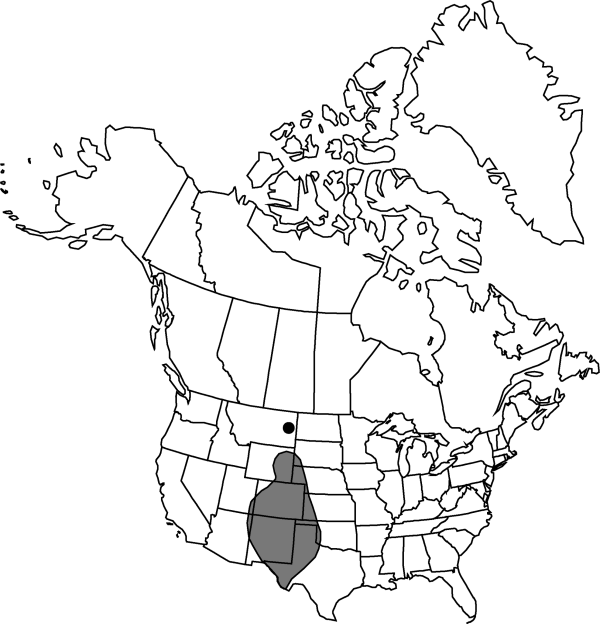Difference between revisions of "Abronia fragrans"
Hooker’s J. Bot. Kew Gard. Misc. 5: 261. 1853.
FNA>Volume Importer |
FNA>Volume Importer |
||
| Line 17: | Line 17: | ||
}}<!-- | }}<!-- | ||
| − | --><span class="statement" id="st- | + | --><span class="statement" id="st-undefined" data-properties=""><b>Plants </b>perennial. <b>Stems</b> procumbent to semierect, slightly to moderately branched, elongate, sometimes reddish at base and nodes, glandular-pubescent, viscid. <b>Leaves</b>: petiole 0.5–8 cm; blade ovate to triangular or lanceolate, 3–12 × 1–8 cm, margins entire to subsinuate and slightly undulate, adaxial surface glandular-pubescent, abaxial surface more densely and longer pubescent, or sometimes villous. <b>Inflorescences</b>: peduncle longer than subtending petiole; bracts linear-lanceolate to oval-ovate, 7–25 × 2–12 mm, scarious, glandular-puberulent to short villous; flowers 30–80. <b>Perianth</b>: tube greenish to reddish purple, 10–25 mm, limb white, (2–)6–10 mm diam. <b>Fruits</b> winged or not, fusiform and appearing deeply grooved when wingless, when wings not distorted, fruit ± cordate in profile, tapered at base, with prominent beak in broad notch at apex, 5–12 × 2.5–7 mm, indurate, rugose veined or, if wings distorted, fruit ± rhombic in profile and tapered at both ends, or obdeltate and truncate at apex, with prominent beak; wings 4–5, thick, narrow, not dilated at apex, cavities extending throughout; peripheral fruits often distorted, S-shaped in lateral view.</span><!-- |
-->{{Treatment/Body | -->{{Treatment/Body | ||
| + | |phenology=Flowering spring–fall. | ||
|habitat=Dry sandy soils, scrub and grasslands | |habitat=Dry sandy soils, scrub and grasslands | ||
|elevation=400-2000 m | |elevation=400-2000 m | ||
| Line 38: | Line 39: | ||
|basionyms= | |basionyms= | ||
|family=Nyctaginaceae | |family=Nyctaginaceae | ||
| + | |phenology=Flowering spring–fall. | ||
|habitat=Dry sandy soils, scrub and grasslands | |habitat=Dry sandy soils, scrub and grasslands | ||
|elevation=400-2000 m | |elevation=400-2000 m | ||
| Line 45: | Line 47: | ||
|publication year=1853 | |publication year=1853 | ||
|special status= | |special status= | ||
| − | |source xml=https://jpend@bitbucket.org/aafc-mbb/fna- | + | |source xml=https://jpend@bitbucket.org/aafc-mbb/fna-data-curation.git/src/9216fc802291cd3df363fd52122300479582ede7/coarse_grained_fna_xml/V4/V4_119.xml |
|genus=Abronia | |genus=Abronia | ||
|species=Abronia fragrans | |species=Abronia fragrans | ||
| − | |||
| − | |||
| − | |||
| − | |||
| − | |||
| − | |||
| − | |||
| − | |||
| − | |||
| − | |||
| − | |||
| − | |||
| − | |||
| − | |||
| − | |||
| − | |||
| − | |||
| − | |||
| − | |||
| − | |||
| − | |||
| − | |||
| − | |||
| − | |||
| − | |||
| − | |||
| − | |||
| − | |||
| − | |||
| − | |||
| − | |||
| − | |||
| − | |||
| − | |||
| − | |||
| − | |||
| − | |||
| − | |||
| − | |||
| − | |||
| − | |||
| − | |||
}}<!-- | }}<!-- | ||
-->[[Category:Treatment]][[Category:Abronia]] | -->[[Category:Treatment]][[Category:Abronia]] | ||
Revision as of 13:56, 27 July 2019
Plants perennial. Stems procumbent to semierect, slightly to moderately branched, elongate, sometimes reddish at base and nodes, glandular-pubescent, viscid. Leaves: petiole 0.5–8 cm; blade ovate to triangular or lanceolate, 3–12 × 1–8 cm, margins entire to subsinuate and slightly undulate, adaxial surface glandular-pubescent, abaxial surface more densely and longer pubescent, or sometimes villous. Inflorescences: peduncle longer than subtending petiole; bracts linear-lanceolate to oval-ovate, 7–25 × 2–12 mm, scarious, glandular-puberulent to short villous; flowers 30–80. Perianth: tube greenish to reddish purple, 10–25 mm, limb white, (2–)6–10 mm diam. Fruits winged or not, fusiform and appearing deeply grooved when wingless, when wings not distorted, fruit ± cordate in profile, tapered at base, with prominent beak in broad notch at apex, 5–12 × 2.5–7 mm, indurate, rugose veined or, if wings distorted, fruit ± rhombic in profile and tapered at both ends, or obdeltate and truncate at apex, with prominent beak; wings 4–5, thick, narrow, not dilated at apex, cavities extending throughout; peripheral fruits often distorted, S-shaped in lateral view.
Phenology: Flowering spring–fall.
Habitat: Dry sandy soils, scrub and grasslands
Elevation: 400-2000 m
Distribution

Ariz., Colo., Kans., Mont., Nebr., N.Mex., N.Dak., Okla., S.Dak., Tex., Utah, Wyo., Mexico (Chihuahua).
Discussion
Selected References
None.
